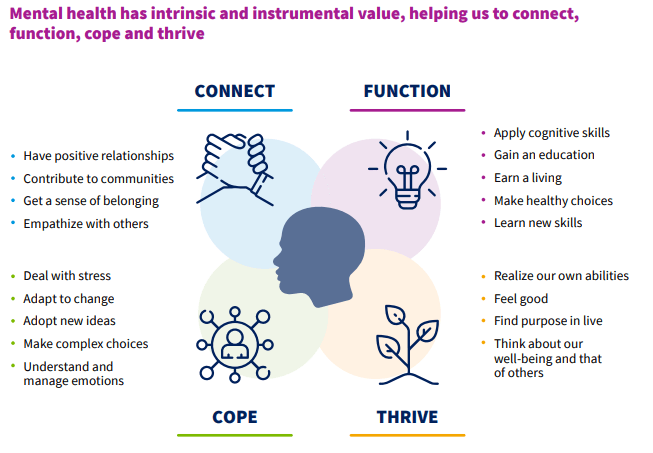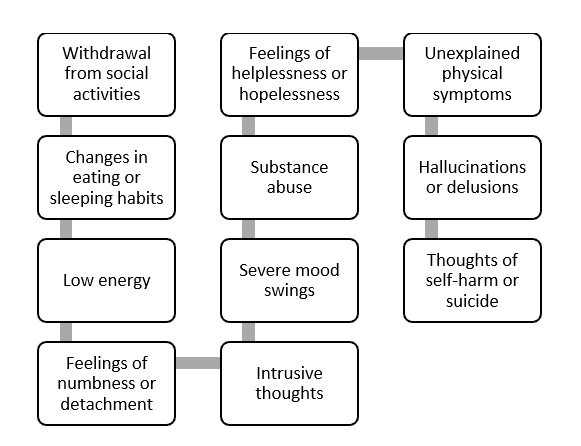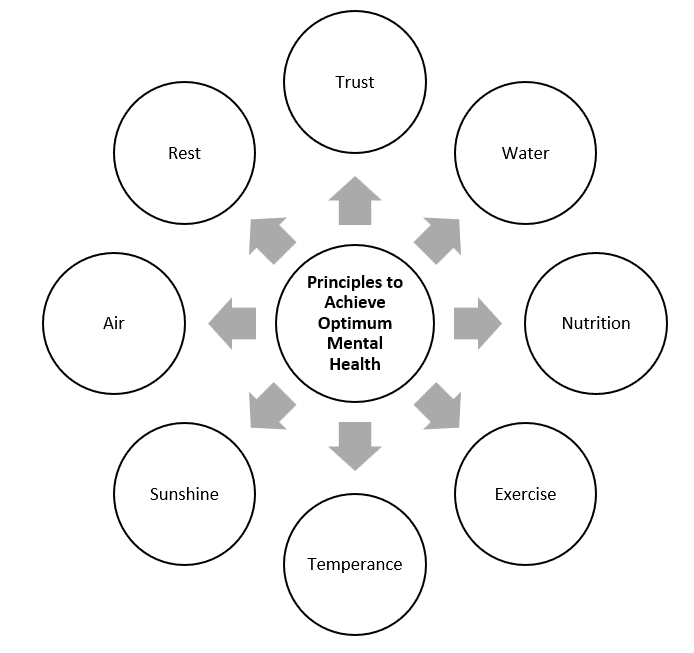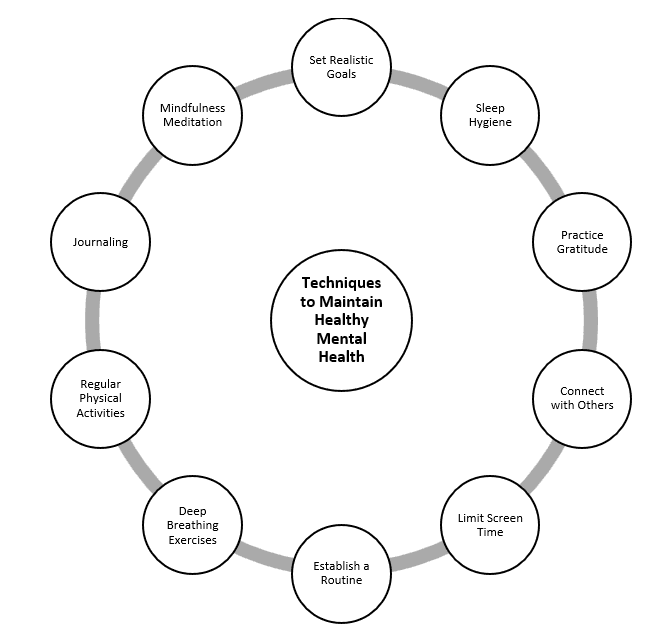Understanding Mental Health
Mental health is an important aspect of our overall well-being that goes beyond the absence of mental illness. Just as physical health is not simply the absence of disease but the presence of vitality and well-being, it involves a state of emotional, psychological, and social balance that helps us navigate life’s challenges.
But what exactly is it, and how can we recognize the signs of potential mental health issues?

Read More- Mental Health and Well-Being
What is Mental Health?
Mental health is a broad concept that covers our emotional, psychological, and social well-being. It plays a significant role in how we think, feel, and behave in our daily lives. Our mental health affects our ability to cope with stress, relate to others, and make decisions. It influences how we handle everyday situations, whether they’re major challenges or small inconveniences.
Freud (1930) defined it as “the ability to love and to work.” Freud emphasized that a psychologically healthy individual should be able to form meaningful relationships and engage productively in work and society.
Whereas Rogers (1961) defined it as the “process of becoming a fully functioning person.” According to Rogers, this involves openness to experience, living in harmony with one’s true self, and maintaining a positive sense of self-worth. He believed it is the ability to grow and fulfill one’s potential.
According to American psychological Association, mental health is a state of mind characterized by emotional well-being, good behavioral adjustment, relative freedom from anxiety and disabling symptoms, and a capacity to establish constructive relationships and cope with the ordinary demands and stresses of life.
At its core, mental health involves feeling balanced and able to function effectively in daily life. It doesn’t mean feeling happy all the time, but it does mean having the capacity to deal with life’s ups and downs in a healthy way. People with good mental health are able to manage their emotions, maintain healthy relationships, and recover from setbacks.
Mental Health vs. Mental Illness
A common misconception is that mental health simply means the absence of mental illness. However, it is more than just the lack of mental disorders. It also involves the presence of positive attributes, such as the ability to enjoy life, feel hopeful, and engage meaningfully in activities. Someone may not have a diagnosed mental illness but still struggle with poor mental health if they are constantly stressed, lack purpose, or feel disconnected from others.
On the other hand, mental illness refers to a wide range of mental health conditions that affect mood, thinking, and behavior. Conditions such as depression, anxiety disorders, schizophrenia, and bipolar disorder are examples of mental illnesses that can significantly impair a person’s ability to function.
The World Health Organization (WHO) defines health as “a state of complete physical, mental, and social well-being and not merely the absence of disease or infirmity.” This definition highlights that true health encompasses all aspects of a person’s life, including their mental well-being.
Similarly, the American Psychological Association (APA) defines it as a state characterized by emotional well-being, good behavioral adjustment, relative freedom from anxiety and disabling symptoms, and the ability to establish constructive relationships and cope with life’s ordinary demands. Both of these definitions emphasize that mental health involves more than just avoiding illness — it’s about thriving.
Importance of Mental Health
Mental health is important at every stage of life, from childhood through adulthood. Our mental health influences how we approach life’s challenges, how we interact with others, and how we perceive ourselves and the world around us. It also affects physical health. For example, poor mental health can weaken the immune system, increase the risk of heart disease, and lead to unhealthy behaviors such as smoking or substance abuse.
Good mental health is essential for personal well-being, healthy relationships, and productive work life. When it is compromised, it can affect every aspect of a person’s life, leading to difficulties at work, strained relationships, and even physical health problems.
Our mental health is as important as our physical health. When we have mental health we can cope with the stresses of life, realize our own abilities, learn and work well and contribute actively to our communities. Having mental health means we are better able to connect, function, cope and thrive

Importance of Mental Health
Factors Affecting Mental Health
There are many factors that influence our mental health. Some of the key factors include-
- Biological Factors– These include genetics, brain chemistry, and physical health. Some people may be more prone to mental health issues due to their genetic makeup or chemical imbalances in the brain. For example, a family history of depression may increase a person’s likelihood of experiencing depression themselves.
- Life Experiences– Traumatic or stressful experiences, especially in childhood, can have a lasting impact on mental health. Abuse, neglect, the loss of a loved one, or exposure to violence are all examples of experiences that can negatively affect mental health.
- Social Environment– Our relationships and social networks play a crucial role in our mental health. Having a strong support system can protect against mental health problems, while isolation and loneliness can increase the risk of mental illness.
- Cultural and Societal Factors– Cultural beliefs and societal norms can also shape how we perceive mental health and illness. In some cultures, there may be stigma associated with seeking help for mental health issues, which can prevent individuals from getting the care they need.
- Economic and Environmental Factors– Financial stress, unemployment, poor living conditions, and exposure to violence or environmental disasters can also take a toll on mental health. Economic insecurity and the pressure to meet basic needs can increase anxiety and stress, making it harder to maintain mental well-being.
Mental Health Statistics in India
In India, mental health remains a significant concern, with millions of people affected by various mental health disorders. According to a study conducted by the National Institute of Mental Health and Neuro Sciences (NIMHANS) from 2014 to 2016:
- 10% of the population suffers from common mental disorders, such as anxiety and depression.
- 9% of the population suffers from severe mental health disorders, which can include conditions like schizophrenia or bipolar disorder.
- 7% of the Indian population will be diagnosed with a mental disorder at least once in their lifetime.
These statistics indicate that mental health issues are widespread in India, affecting a significant portion of the population. Despite the high prevalence of mental health disorders, many people do not seek help due to the stigma surrounding mental illness, lack of awareness, and limited access to mental health services.
Burden of Mental Health Problems in India
The burden of mental health problems in India is immense, not only in terms of human suffering but also in economic costs. The World Health Organization (WHO) estimates that India has 2,443 disability-adjusted life years (DALYs) per 100,000 population due to mental health problems. DALYs represent the number of years lost due to disability or death caused by mental illness.
The suicide rate in India is also alarmingly high, with an age-adjusted suicide rate of 21.1 per 100,000 population. Suicide is one of the leading causes of death, especially among young people, highlighting the urgent need for mental health interventions and support.
The economic loss due to mental health conditions in India between 2012 and 2030 is projected to be USD 1.03 trillion. This staggering figure underscores the need for increased investment in mental health care, early intervention, and support services.
Early Warning Signs of Mental Health Problems

Early Warning Signs of Mental Health Problems
Recognizing the early warning signs of mental health problems is crucial for timely intervention and support. Some of the common signs (they should persists for a prolonged period) include-
- Changes in eating or sleeping habits– Eating too much or too little, or experiencing insomnia or excessive sleep, can be indicators of mental health issues.
- Withdrawal from social activities– Pulling away from friends, family, and usual activities is a common sign of depression or anxiety.
- Low energy– Feeling fatigued or lacking motivation can signal mental health problems like depression.
- Feelings of numbness or detachment– Feeling like nothing matters or being emotionally disconnected from others is a red flag for mental health struggles.
- Unexplained physical symptoms– Persistent aches, pains, or other unexplained physical complaints can sometimes be related to mental health.
- Feelings of helplessness or hopelessness– Feeling like there’s no way out of a situation or that things will never get better is a common symptom of depression.
- Substance abuse– Turning to drugs, alcohol, or smoking more than usual can be a sign of an underlying mental health problem.
- Severe mood swings– Extreme changes in mood, from high energy to deep sadness, can be a sign of bipolar disorder or other mental health conditions.
- Intrusive thoughts– Persistent, unwanted thoughts or memories, especially if they’re disturbing or distressing, can be symptoms of anxiety or post-traumatic stress disorder (PTSD).
- Hallucinations or delusions- Hearing voices, seeing things that aren’t there, or holding irrational beliefs can be symptoms of psychosis or schizophrenia.
- Thoughts of self-harm or suicide- If someone is thinking of harming themselves or others, it is a serious warning sign that immediate help is needed.
Common Mental Health Disorders
Mental health disorders vary in type and severity, but some of the most common include-
- Phobias– These are intense, irrational fears of specific objects or situations, such as heights, spiders, or flying.
- Anxiety Disorders– Generalized anxiety disorder (GAD), panic disorder, and social anxiety disorder are all characterized by excessive worry, fear, and panic attacks.
- Depression– One of the most common mental health disorders, depression involves persistent feelings of sadness, hopelessness, and loss of interest in activities once enjoyed.
- Eating Disorders– Conditions like anorexia nervosa, bulimia nervosa, and binge-eating disorder involve unhealthy relationships with food and body image.
- Personality Disorders- These include conditions such as borderline personality disorder (BPD) and antisocial personality disorder, where a person’s patterns of thinking and behaving deviate from cultural expectations and cause significant distress or impairment.
- Post-Traumatic Stress Disorder (PTSD)– PTSD can develop after experiencing or witnessing a traumatic event, leading to flashbacks, nightmares, and severe anxiety.
- Obsessive-Compulsive Disorder (OCD)- OCD involves unwanted, intrusive thoughts (obsessions) and repetitive behaviors (compulsions) aimed at reducing anxiety.
- Panic Disorder– Characterized by sudden, repeated panic attacks, panic disorder causes intense fear and physical symptoms such as a racing heart and shortness of breath.
8 Principles to Achieve Optimum Mental Health

Principles to Achieve Optimum Mental Health
Dan Banos, a clinical psychologist, has outlined eight principles to achieve and maintain good mental health. These principles focus on lifestyle changes that can positively impact mental well-being-
- Nutrition- Eating a balanced diet rich in nutrients is essential for both physical and mental health. Certain foods, such as those high in omega-3 fatty acids, are linked to improved mood and cognitive function.
- Exercise- Regular physical activity is known to reduce symptoms of depression and anxiety. Exercise releases endorphins, the body’s natural mood boosters.
- Water- Staying hydrated is vital for brain function. Dehydration can lead to cognitive decline, irritability, and fatigue.
- Sunshine- Sunlight exposure helps the body produce vitamin D, which is linked to mood regulation. Lack of sunlight can lead to conditions like seasonal affective disorder (SAD).
- Temperance- Practicing moderation in all areas of life, including diet, alcohol consumption, and screen time, is important for maintaining mental balance.
- Air- Fresh air and proper ventilation improve oxygen flow to the brain, enhancing mental clarity and mood.
- Rest- Getting enough sleep is crucial for it. Sleep allows the brain to recharge, process information, and manage emotions effectively.
- Trust- Building trusting relationships with others fosters a sense of connection and security, which is vital for emotional well-being.
Techniques to Maintain Healthy Mental Health

Techniques to Maintain Mental Health
- Mindfulness Meditation- Spend a few minutes each day sitting quietly and focusing on your breath. Notice your thoughts without judgment and gently bring your focus back to your breath. A meta-analysis published in JAMA Internal Medicine found that mindfulness meditation programs can improve anxiety, depression, and pain (Goyal et al., 2014). Participants in these programs showed significant reductions in symptoms compared to control groups.
- Journaling- Write down your thoughts and feelings in a journal. You can reflect on your day, express gratitude, or explore your emotions. Research published in the journal Psychological Science indicated that expressive writing can lead to improvements in it. A study showed that participants who engaged in expressive writing experienced reduced symptoms of depression and anxiety (Pennebaker & Chung, 2011).
- Regular Physical Activity- Engage in at least 30 minutes of physical activity most days of the week. This can include walking, jogging, dancing, or any other activity you enjoy. A review published in The American Journal of Psychiatry concluded that regular exercise is associated with reduced symptoms of depression and anxiety. It suggested that physical activity can be as effective as medication for some individuals with mild to moderate depression (Blumenthal et al., 2007).
- Deep Breathing Exercises- Take a few minutes to practice deep breathing. Inhale slowly through your nose, hold for a few seconds, and then exhale slowly through your mouth. A study published in The Journal of Clinical Psychology found that deep breathing exercises can significantly reduce stress and anxiety levels. Participants who practiced deep breathing showed lower levels of cortisol, a stress hormone, compared to those who did not (Niemann et al., 2014).
- Establish a Routine- Create a daily schedule that includes time for work, relaxation, and self-care activities. Research has shown that having a structured daily routine can help alleviate stress and anxiety, particularly in children and adolescents. A study in The Journal of Developmental & Behavioral Pediatrics found that children with consistent routines reported lower levels of anxiety (Davis et al., 2017).
- Limit Screen Time- Set boundaries around your use of electronic devices, especially social media. Try to take regular breaks from screens. A study published in The Lancet Child & Adolescent Health found that increased screen time, especially on social media, is associated with higher levels of anxiety and depression in adolescents. Reducing screen time can lead to better mental health outcomes (Raaijmakers et al., 2018).
- Connect with Others- Reach out to friends, family, or support groups. Spend time with loved ones and engage in meaningful conversations. A study published in Health Psychology found that social support significantly predicts it and well-being. Participants with stronger social connections reported lower levels of depression and stress (Uchino, 2009).
- Practice Gratitude- Each day, write down three things you are grateful for. Focus on both big and small aspects of your life. Research published in the journal Emotion found that practicing gratitude can lead to increased feelings of well-being and life satisfaction. Participants who kept gratitude journals reported improved mood and reduced symptoms of depression (Emmons & McCullough, 2003).
- Sleep Hygiene- Establish a consistent sleep schedule by going to bed and waking up at the same time each day. Create a relaxing bedtime routine and a comfortable sleep environment. A study published in Sleep Health found that poor sleep quality is strongly associated with it are issues such as anxiety and depression. Good sleep hygiene practices significantly improve overall mental health (Lund et al., 2010).
- Set Realistic Goals- Break down larger tasks into smaller, manageable goals. Celebrate your achievements, no matter how small. Set SMART goals or goals that are Specific, Measurable, Achievable, Relevant, and Time-Bound. Research published in Psychological Bulletin suggests that setting specific and achievable goals can improve motivation and well-being. Individuals who set and achieved their goals reported higher levels of life satisfaction (Locke & Latham, 2002).
Mental Health Helplines in India
If you or someone you know is struggling with mental health issues, help is available. In India, the following helplines provide support for mental health and suicide prevention-
- NIMHANS Helpline- 080 – 4611 0007 (24/7 toll-free helpline for mental health support)
- Kiran Helpline- 1800-599-0019 (A national 24/7 toll-free helpline launched by the Ministry of Social Justice and Empowerment)
- Man-Samvad Helpline- 020-26127331 (Suicide prevention helpline by Sassoon Hospital)
- Connecting NGO Distress Helpline- 9922004305 / 9922001122 (For individuals experiencing distress or suicidal thoughts)
Conclusion
Mental health is an integral part of our overall well-being, and it deserves the same attention and care as physical health. Recognizing the signs of mental health issues, understanding common disorders, and knowing where to seek help can make a significant difference in managing and improving mental well-being. By incorporating healthy lifestyle choices, building supportive relationships, and seeking professional help when needed, we can all strive toward better it and a more fulfilling life.
The more we understand it, the more we can break the stigma surrounding it and encourage open conversations about mental well-being. Whether through self-care practices, therapy, or support from loved ones, it is something that can be nurtured and strengthened for a better quality of life.
Choosing to heal is the bravest step you can take. For mental health support, reach out to us on careershodh@gmail.com or find us at @careershodh
References
American Psychological Association. (n.d.). Understanding mental health. https://www.apa.org/topics/mental-health
Blumenthal, J. A., Babyak, M. A., Hinderliter, A., et al. (2007). Exercise and pharmacotherapy in the treatment of major depressive disorder. American Journal of Psychiatry, 164(4), 611-618. https://doi.org/10.1176/ajp.2007.164.4.611
Davis, T. E., Lutz, C. J., & Lutz, L. (2017). Structured routines help children manage stress and anxiety. Journal of Developmental & Behavioral Pediatrics, 38(6), 397-405. https://doi.org/10.1097/DBP.0000000000000558
Emmons, R. A., & McCullough, M. E. (2003). Counting blessings versus burdens: An experimental investigation of gratitude and subjective well-being in daily life. Emotion, 3(3), 300-310. https://doi.org/10.1037/1528-3542.3.3.300
Freud, S. (1930). The meaning of anxiety. Hogarth Press.
Goyal, M., Singh, S., Sibinga, E. M. S., et al. (2014). Meditation programs for psychological stress and well-being: A systematic review and meta-analysis. JAMA Internal Medicine, 174(3), 357-368. https://doi.org/10.1001/jamainternmed.2013.13018
Locke, E. A., & Latham, G. P. (2002). Building a practically useful theory of goal setting and task motivation: A 35-year odyssey. American Psychologist, 57(9), 705-717. https://doi.org/10.1037/0003-066X.57.9.705
López-Castroman, J., & Moya, A. (2021). Mental health in India: The current state and future directions. International Journal of Social Psychiatry, 67(1), 28-35. https://doi.org/10.1177/0020764020974928
Lund, H. G., Reider, B. D., Whiting, A. B., & Prichard, J. R. (2010). Sleep patterns and predictors of disturbed sleep in children and adolescents. Sleep Health, 1(3), 104-110. https://doi.org/10.1016/j.sleh.2014.01.004
National Institute of Mental Health and Neuro Sciences (NIMHANS). (2016). National Mental Health Survey of India 2015-2016. Ministry of Health and Family Welfare. https://www.nimhans.ac.in
Niemann, Y.-F., Gutzwiller, R., & Popp, R. (2014). The impact of deep breathing on stress and anxiety: A randomized controlled trial. The Journal of Clinical Psychology, 70(2), 110-115. https://doi.org/10.1002/jclp.22015
Pennebaker, J. W., & Chung, C. K. (2011). Expressive writing: Connections to physical and mental health. Health Psychology, 30(6), 641-646. https://doi.org/10.1037/a0025768
Raaijmakers, L. A., van den Eijnden, R. J., & Meeus, W. (2018). Social media use and mental health: A longitudinal study of adolescents. The Lancet Child & Adolescent Health, 2(5), 310-318. https://doi.org/10.1016/S2352-4642(18)30078-8
Rogers, C. R. (1961). On becoming a person: A therapist’s view of psychotherapy. Houghton Mifflin.
Uchino, B. N. (2009). Understanding the links between social support and physical health: A life-span perspective with emphasis on the separability of perceived and received support. Health Psychology, 28(3), 423-430. https://doi.org/10.1037/a0015770
World Health Organization. (2001). The world health report 2001: Mental health: New understanding, new hope. https://www.who.int/whr/2001/en/
World Health Organization. (2019). Mental health: A state of well-being. https://www.who.int/news-room/fact-sheets/detail/mental-health-strengthening-our-response
Subscribe to Careershodh
Get the latest updates and insights.
Join 13,984 other subscribers!
Niwlikar, B. A. (2024, October 4). What is Mental Health and Discover 10 Easy Techniques to Achieve it. Careershodh. https://www.careershodh.com/mental-health-1/
